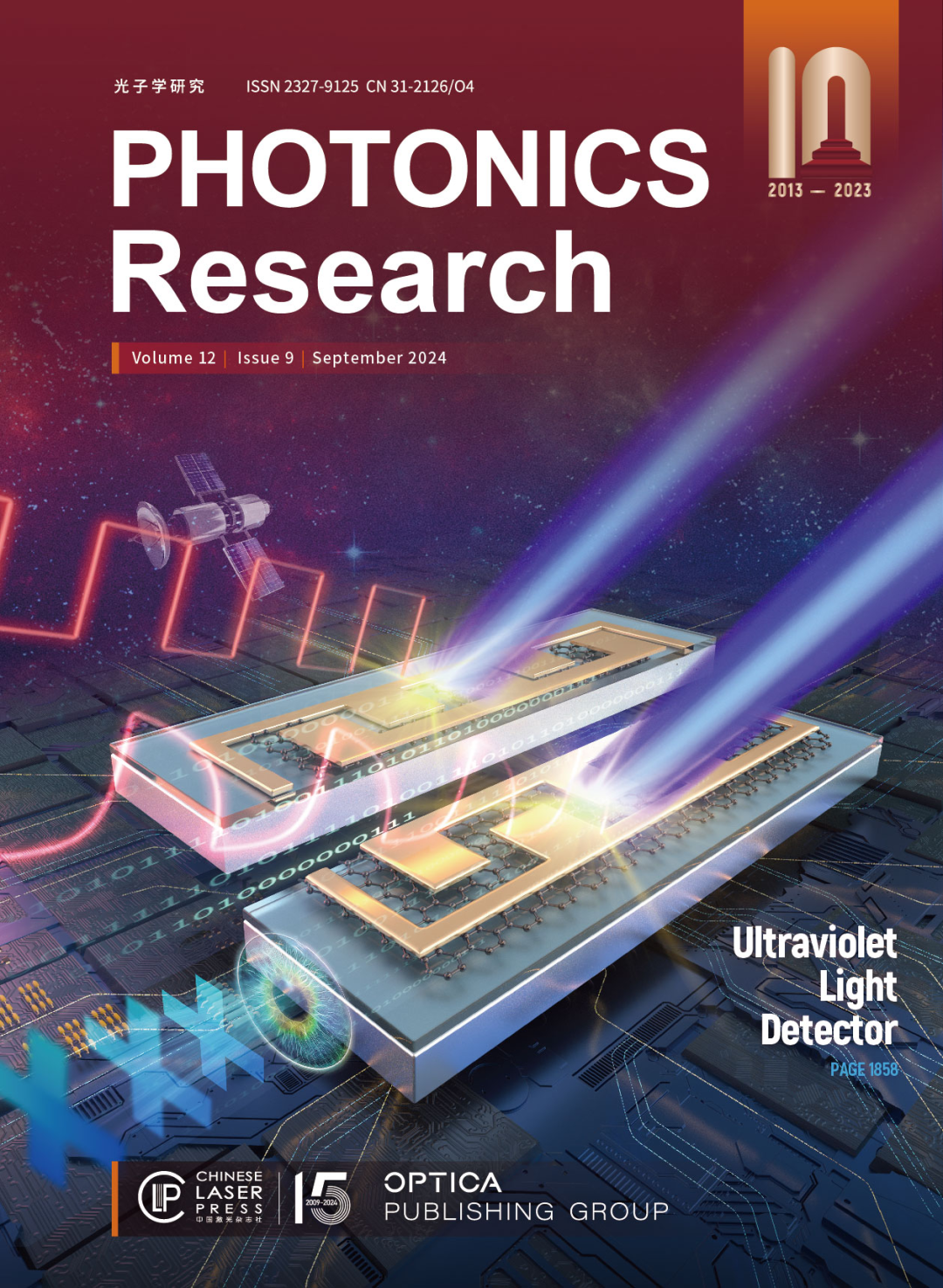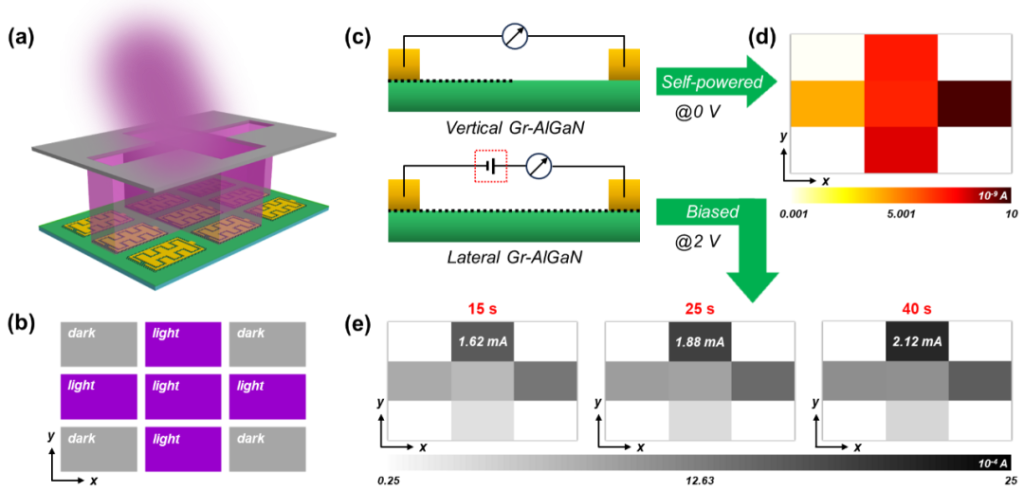Graphene-Nitride van der Waals Heterojunction Ultraviolet Photodetectors and Imaging
Photonics Research, Issue 9, 2024 (Cover Article):

Yuanyuan Yue, Yang Chen, Jianhua Jiang, Lin Yao, Haiyu Wang, Shanli Zhang, Yuping Jia, Ke Jiang, Xiaojuan Sun, Dabing Li.
“Configuration design of a 2D graphene/3D AlGaN van der Waals junction for high-sensitivity and self-powered ultraviolet detection and imaging.” Photonics Res. 12, 1858 (2024)
Introduction and Research Background
Solar-blind ultraviolet (UV) detectors are critical for both military and civilian applications, such as space security communications, missile warning systems, and biomedical imaging, showcasing tremendous value. However, improving the photodetection performance of these devices remains a challenge due to the low conductivity and short carrier mobility of high-aluminum-content nitride materials. Nitride semiconductors are excellent candidates for such devices, and their combination with graphene forms van der Waals heterojunctions, providing an ideal interface with enhanced electronic properties. Graphene, acting as a transparent UV window, offers ultrahigh carrier mobility and tunable electronic properties, opening new avenues for flexible UV photodetector design.
This study introduces a graphene-nitride van der Waals heterojunction UV photodetector with a ring-shaped electrode structure. Without the need for an interfacial dielectric layer, this design allows both horizontal and vertical detector configurations simply by adjusting the relative position of the electrodes. These devices demonstrate high sensitivity and self-powered photoresponse, offering new capabilities for customized imaging applications. This work represents a significant advancement in the field of nitride-based UV photodetectors, providing innovative insights for future multifunctional UV optoelectronic devices.
Importance of Solar-Blind UV Detection
Solar-blind UV detection focuses on wavelengths between 200–280 nm, which are strongly absorbed by Earth’s atmosphere. This property provides a high signal-to-noise ratio and high accuracy in identifying artificial targets, making it highly advantageous for target monitoring and recognition.
Third-generation nitride semiconductors, with their wide tunable bandgaps and intrinsic light absorption covering the entire solar-blind UV range, are ideal for fabricating such photodetectors. Meanwhile, graphene’s atomic-scale thickness ensures excellent UV transparency. Its high carrier mobility, environmental stability, and mechanical flexibility make it highly attractive for diverse photodetector designs. Notably, the absence of dangling bonds on graphene’s surface allows the formation of high-quality van der Waals heterojunctions with nitrides, establishing it as an “ideal partner” for nitride-based UV photodetectors.
Challenges in Device Design and the Novel Approach
Current graphene-nitride UV photodetectors are primarily classified into two configurations: horizontal and vertical structures. However, vertical devices typically require interfacial dielectric layers or etched structures, complicating fabrication and increasing technical difficulty. Additionally, the performance characteristics of these devices vary significantly across different structures, necessitating a deeper understanding of their working mechanisms to guide practical applications.
To address these challenges, the research team led by Professor Dabing Li from the Changchun Institute of Optics, Fine Mechanics and Physics (CAS), in collaboration with Yuanyuan Yue from Jilin University of Finance and Economics and Professor Haiyu Wang from Jilin University, designed a ring-shaped electrode structure for a graphene-nitride UV photodetector. This innovative structure enables both horizontal and vertical configurations simply by adjusting the electrode position relative to graphene. Notably, no dielectric layer is required for the vertical configuration, simplifying the fabrication process.
Device Performance and Working Mechanisms
1. Horizontal and Vertical Structure Designs
- Horizontal Structure: In this configuration, nitrides absorb UV photons, generating electron-hole pairs. The built-in junction field at the interface separates the photogenerated carriers, with electrons drifting into graphene to recombine with its intrinsic holes, reducing conductivity and resulting in a negative photoresponse. The trap states in nitrides extend the carrier lifetime, enabling persistent photoconductivity and high gain.
- Vertical Structure: The dark current of the vertical device follows a rectifying characteristic curve, with a high on/off current ratio of 10⁵ at zero bias, indicating excellent self-powered operation. The photogenerated carriers accumulate at the heterojunction interface, forming a photovoltage of 0.21 V, which drives a photocurrent without any external bias.

<figure> <figcaption>**Figure 1:** Schematic of horizontal (a) and vertical (b) structure UV photodetectors</figcaption> </figure>
2. Electrical Response and Imaging Capabilities

The electrical performance and imaging characteristics of both structures were evaluated (Figure 2).
- High Sensitivity and Self-Powered Operation: The horizontal structure achieved 3.88 × 10¹² Jones at 2 V, while the vertical structure demonstrated 1.34 × 10¹¹ Jones at 0 V, making it suitable for self-powered applications.
- Fast Response and Recovery: The vertical structure exhibited rapid response and recovery, with excellent dark-to-light current ratios.

- Imaging Applications: The researchers developed a UV photodetector array and compared the imaging performance of the two structures (Figure 3).
3. Imaging Test Results
- Vertical Structure Array: The vertical device array rapidly imaged a “+” target at zero bias with high contrast and temporal stability, making it ideal for deep space exploration and other extreme environments.
- Horizontal Structure Array: This configuration provided high-definition target images, with clarity improving over time through signal accumulation. The system is particularly effective for detecting static targets emitting weak light, and the initial photoresponse was significantly enhanced within a few seconds, stabilizing thereafter. This property makes it promising for biomimetic visual imaging and neural network-inspired memory applications.
<figure> <figcaption>**Figure 2:** Current-voltage characteristics and response mechanisms for (a) horizontal and (b) vertical structures</figcaption> </figure>
Conclusion and Future Directions
According to Professor Dabing Li, nitride-based solar-blind UV photodetectors offer significant advantages in applications where low background noise and high recognition accuracy are critical. This work demonstrates how the graphene-nitride van der Waals heterojunction leverages the complementary properties of multiple materials, optimizing structure and enhancing device performance.
The development of horizontal and vertical UV photodetectors without interfacial dielectric layers highlights the importance of structural flexibility in meeting application-specific needs. The imaging tests validate the tunability of these devices, further expanding their potential in specialized fields like space exploration and biomimetic imaging.
This research provides valuable insights into the design and development of next-generation multifunctional UV photodetectors.
Reference:
“Configuration design of a 2D graphene/3D AlGaN van der Waals junction for high-sensitivity and self-powered ultraviolet detection and imaging,” Photonics Research, Issue 9, 2024.

